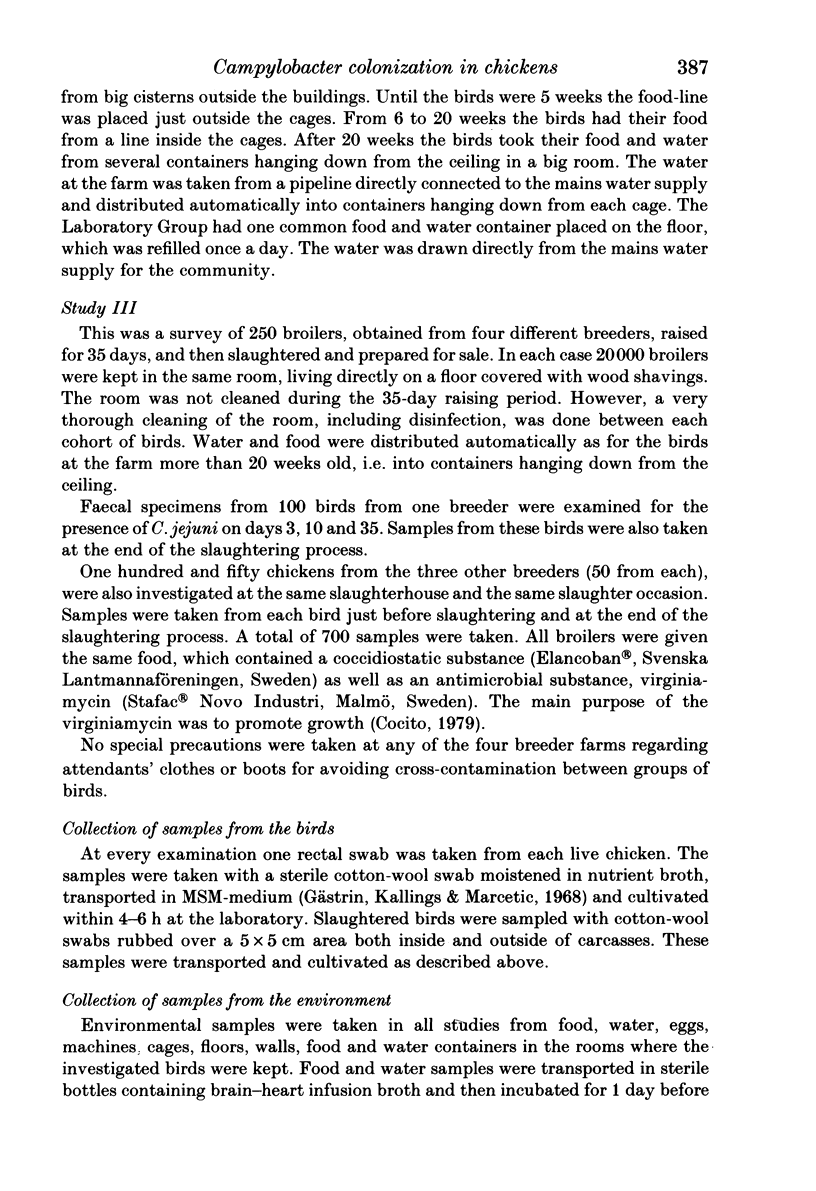Abstract
A cross-sectional study of 447 laying hens (age range 0-65 weeks) and a longitudinal study of 164 similar birds showed that Campylobacter jejuni was not present in the faeces of newly hatched chicks, but that colonization arose after 5-9 weeks. A survey of 250 broilers obtained from four breeders showed that all were negative for C. jejuni before and after slaughter at the age of 5 weeks. Once C. jejuni had appeared in a flock, it rapidly spread to virtually all birds, but at the age of 42 weeks only 20-46% of birds remained colonized, possibly as a result of having developed immunity. Birds housed in the protective environment of a laboratory still became colonized (after 9 weeks). The mode of infection is unknown, but water and food were bacteriologically negative and were deemed to be unlikely sources. Transmission via attendants, flies or other insects remain possibilities. It is concluded that prevention of colonization might be possible within the life-span of broiler chickens (5-7 weeks), but that it would be difficult to extend this period. There is a need to define how colonization arises so that the feasibility and cost of possible preventive measures can be assessed.
Full text
PDF






Selected References
These references are in PubMed. This may not be the complete list of references from this article.
- Blaser M. J., Taylor D. N., Feldman R. A. Epidemiology of Campylobacter jejuni infections. Epidemiol Rev. 1983;5:157–176. doi: 10.1093/oxfordjournals.epirev.a036256. [DOI] [PubMed] [Google Scholar]
- Cocito C. Antibiotics of the virginiamycin family, inhibitors which contain synergistic components. Microbiol Rev. 1979 Jun;43(2):145–192. doi: 10.1128/mr.43.2.145-192.1979. [DOI] [PMC free article] [PubMed] [Google Scholar]
- Gästrin B., Kallings L. O., Marcetic A. The survival time for different bacteria in various transport media. Acta Pathol Microbiol Scand. 1968;74(3):371–380. doi: 10.1111/j.1699-0463.1968.tb03490.x. [DOI] [PubMed] [Google Scholar]
- Olesiuk O. M., Snoeyenbos G. H., Smyser C. F. Inhibitory effect of used litter on salmonella typhimurium transmission in the chicken. Avian Dis. 1971 Jan-Mar;15(1):118–124. [PubMed] [Google Scholar]
- Skirrow M. B. Campylobacter enteritis - the first five years. J Hyg (Lond) 1982 Oct;89(2):175–184. doi: 10.1017/s0022172400070704. [DOI] [PMC free article] [PubMed] [Google Scholar]
- Skirrow M. B. Campylobacter enteritis: a "new" disease. Br Med J. 1977 Jul 2;2(6078):9–11. doi: 10.1136/bmj.2.6078.9. [DOI] [PMC free article] [PubMed] [Google Scholar]
- Soerjadi-Liem A. S., Snoeyenbos G. H., Weinack O. M. Comparative studies on competitive exclusion of three isolates of Campylobacter fetus subsp. jejuni in chickens by native gut microflora. Avian Dis. 1984 Jan-Mar;28(1):139–146. [PubMed] [Google Scholar]
- Svedhem A., Kaijser B., Sjögren E. The occurrence of Campylobacter jejuni in fresh food and survival under different conditions. J Hyg (Lond) 1981 Dec;87(3):421–425. doi: 10.1017/s0022172400069667. [DOI] [PMC free article] [PubMed] [Google Scholar]


